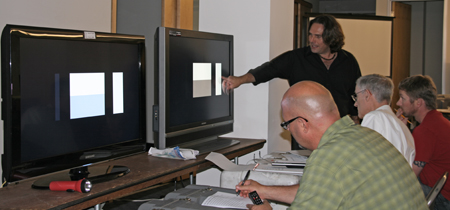
My blog is a bit later than usual this week, but I've
been pretty busy. Tom Norton and I are taking the newly developed
video-technician training course offered by THX at the company's
headquarters in San Rafael, California, just north of San Francisco in
Marin County. Tuesday was the first of three full days of instruction
and hands-on lab work, after which some of us went out to dinner and
caught Hugh Masekela's set at Yoshi's, a famous jazz spot in Oakland.
After a wrong turn by Laurie Fincham, THX's brilliant but directionally
challenged chief scientist—thanks for the grand tour of San Francisco,
Laurie!—I just got back to my room.
Now, you might wonder why Tom and I need to take such a
course—after all, we calibrate and review TVs for a living. In fact, we
don't need it; most of the material is very familiar to both of
us. But there's always something to learn, even in one's field of
expertise. Also, we wanted to see how THX was training those who would
then go out and perform calibrations for paying customers.
The curriculum is well-planned, and instructors Gregg Loewen
and Michael Chen present the information in a tag-team fashion, which
helps keep it fresh even after eight hours. They alternate between
PowerPoint slides outlining the basic concepts and procedures for
calibrating a video display and hands-on sessions with 13 different
flat panels and front projectors located around the room. The pace is
fast but relaxed, and questions are encouraged.
One thing I learned is that film has an effective resolution of
about 2600x1400, or 3.7 megapixels. This is roughly twice the
resolution of 1080p, so film should look much sharper than HD video,
right? Wrong. As film is pulled through a projector, it starts and
stops 24 times per second and, as a result, it jiggles around quite a
bit—a phenomenon called "judder"—which reduces apparent resolution.
Also, when the projector's shutter, or "gate," opens for each frame,
the heat of the lamp causes the film to move back and forth, which
changes the focus. These factors reduce film's actual effective
resolution to something like 1.5 megapixels, which is less than 1080p's
2MP. As a result, Blu-ray and commercial digital presentation can
actually look more sharply resolved than film. I've preferred digital
cinema over film since I first saw it, and now I have some evidence
that it is actually better. Take that, film snobs!
Of course, the amount of detail you see is directly related to
your seating distance. The figures I've used here assume a seating
distance of 1.5 times the screen height, which is usually about halfway
back in a typical commercial cinema.
But back to calibrations. As I've maintained for a long time,
the course emphasizes that the single most important thing you can do
to optimize any video display's performance is to set the black level
correctly. The eye is much more sensitive to small changes in low
levels than in high levels.
Next in importance is maximizing the dynamic range (contrast
ratio) by setting the white level correctly. The THX spec for peak
contrast ratio (full on/full off) is 2000:1, and the ANSI
(checkerboard) spec is 200:1, which is better than film can manage.
I've seen many digital video displays that meet or exceed these specs,
which is another reason I prefer digital video to film.
Speaking of ANSI contrast, I haven't been measuring that in my
TV reviews because there is a lot of controversy about the methodology
by which a meaningful result can be obtained. Loewen and Chen advocate
a straightforward approach—simply measure the light levels in each of
the checkerboard squares in a dark environment, average the white and
black levels, and divide the white average by the black average. This
is exactly how I've done it in the past, so I'm considering adding it
to my measurements in the future.
Tuesday was all about setting the basic user
controls—brightness, contrast, color saturation, tint, and sharpness.
Wednesday, we'll tackle grayscale calibration, and Thursday will finish
up with tweaking a set's color-management system (if it has one). Don't
tell our instructors, but Tom and I plan to cut class for a while to
visit THX's video-certification lab, a new service that complements the
company's long-standing audio-certification program.
I'm glad I made this trip to the Bay Area—where I lived for
four years in the '80s and love to this day—and I look forward to
honing my calibration skills further. Anyone who wants a solid
grounding in the art and science of video calibration would be well
served by enrolling in this course, which THX offers at various
locations around the country, including the CEDIA Expo in September.
Check the company's website for more info.
And now, to sleep—another early day awaits.
If you have an audio/video question for me, please send it to scott.wilkinson@sourceinterlink.com.
| 
